Acknowledgments Thanks are due to Ogino Masayoshi, Lecturer in Japanese at the University of Canterbury, New Zealand, for his assistance with installation of software for the electronic version of the Kangxi zidian dictionary, one of the pre-modern Chinese character dictionaries referred to in compiling this book. Thanks also to Kazuko Seeley for her on-call status as unofficial consultant for a number of tricky points relating to Japanese language. Last but not least, recognition is due to Tuttles senior editor Cathy Layne and the Tuttle team for their painstaking work on this book at the production stage.
Appendix
Similarly Shaped Elements Easily Confused 1. The Two Determinatives and
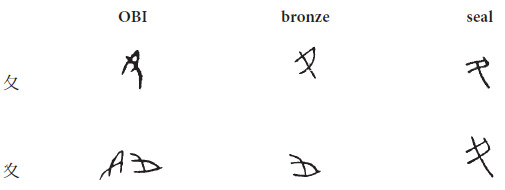
Note: does not occur at any period as an independent graph, only as an element within a compound graph.
The OBI form above for (listed by Gu), of very low frequency of occurrence, is best regarded as provisional. The above table is based on information in MS1995:v1:284-5, GY2008:39, and KJ1970:58. The issue of distinction between (determinative no. 34 in the traditional system of 214) and (determinative no. 35 in the same system) can be confusing. This is due partly, no doubt, to similarity in shape.
There is also the difficulty of clearly interpreting the original meanings. Such difficulties surrounding and are perhaps the reason why the diff erence in shape between the two is not maintained clearly in the authoritative Kangxi zidian (1716) compiled on Imperial command (Peking Palace printed version [early 19th century]), though they are still treated as separate determinatives. In the modern period, was printed for a while in a way which helped distinguish it from (see, for example, the traditional form of 441 love), but that distinctiveness has been lost in the standard computerized fonts. In this book the general trend in interpretation of these two elements has been followed, and so the basic meaning of (determinative 34) is provisionally taken to be descend, come down, or descending foot, while (determinative 35) is taken as drag the foot, walk slowly. 2. as a Component Shape The characters lung(s) 968, (Imperial) We 1731, and fine, cheerful 1005 all feature the element written in the same shape as moon in modern usage, but in these three cases only carries the meaning moon in .
In , the left-hand element is the abbreviated form of in compound graphs (such as ), and in the left-hand element is an abbreviation of boat in compound graphs. According to Qiu, the merging and confusion of the shape of these elements in compound graphs can be seen as early as the clerical script stage. In the earlier part of the modern period, distinctions used to be made in the traditional forms of Ming printed font to reflect the earlier usage, but those distinctions were dispensed with through the process of script simplification. The correct interpretation of in a particular case is explained in the individual entries. 3. as a Component Shape The characters 785 duty and 1742 court, government office both share as a right-hand element in modern texts.
In , the right-hand element (meaning spindle) retains its etymologically correct shape (middle horizontal stroke longer than bottom horizontal). In , though, the right-hand was originally slightly different in shape, i.e., (originally meaning person standing on earthen mound, leading to the extended sense surpass others), with the middle horizontal stroke shorter than the horizontal stroke beneath it to represent earth. Just as in the case of as a component shape (see the immediately preceding section), this subtle distinction in shape is no longer supported in standard fonts for Japanese: only the shape is supported. Explanation regarding the distinction is included in individual entries for relevant graphs. 4. as a Component Shape In Japanese usage, the character change 258, for example, is written with as the right-hand element, but the traditional form has .
Originally, at the OBI stage as an independent character was a pictograph of a person upside down, while originally depicted a persons withered/bent leg, or (by analogy based on the shape) a ladle. In standard Japanese usage, though, the two shapes have been regularized as . Explanation regarding the above distinction is included in individual entries for relevant graphs. APPENDIX
&
BIBLIOGRAPHY
Bibliography Note: This list is arranged in alphabetical order which follows the abbreviated format (author initials followed by year of publication) used in the author references found in the main body of this book. The works in Japanese are all published in Tokyo; works in Chinese are published in Beijing unless shown otherwise.
| AS2007 | Schuessler, A., ABC Etymological Dictionary of Old Chinese . University of Hawaii Press, 2007. |
| BK1957 | Karlgren, B., Grammata Serica Recensa . Reprint, Museum of Far Eastern Antiquities, Stockholm, 1972. |
| CS2000 | Seeley, C., A History of Writing in Japan . Paperback edition, University of Hawaii Press, 2000. |
| DJ2003 | DeFrancis, J. (ed.), ABC Chinese-English Comprehensive Dictionary . University of Hawaii Press, 2003. |
| DJ2009 | Xu Shen, Shuowen jiezi . 3 vols. + CD. + CD. Wanjuan chuban gongsi, 2009. |
| EB1974 | Encyclopedia Britannica (ed.), Encyclopedia Britannica . 15th edition, 29 vols. |
| FC1974 | Fushimi Chkei, Shod daijiten . 2 vols. Kadokawa shoten, 1974. |
| FC1977 | Fushimi Chkei, Shod jiten . Kadokawa shoten, 1977. |
| GY2008 | Gu Yankui, Hanzi yuanliu zidian . Charles E. Charles E. Tuttle, Tokyo, 1999. |
| IJ2013 | Ikeda, J. (ed.), A Guide to Reading and Writing Japanese . 4th edition. Charles E. Tuttle, 2013, Tokyo. |
| KH1988 | Henshall, K.G., A Guide to Remembering Japanese Characters . Charles E. Tuttle, Tokyo, 1988. |
| KJ1970 | Kat Jken, Kanji no kigen . Kadokawa shoten, 1970. |
| KJ1985 | Kat Jken, Kanji no kigen . Kadokawa shoten, 1985. |
| KZ2001 | Zhang Yushu et al., Kangxi zidian (1716). Electronic version (CD) of Peking Palace 1826 printed edition. Personal Media Co., 2001, Tokyo. |
| MR1945 | Mathews, R. Rev. ed. ed. Harvard University Press, 1945 |
| MR2007 | Ma Rusen, Yinxu jiaguxue . Shanghai daxue chubanshe, 2007, Shanghai. |
| MS1995 | Mizukami Shizuo, Kkotsu kinbun jiten . 2 vols. + Supplement ( Bekkan ). Yzankaku, 1995. |
| MT1960 | Morohashi Tetsuji, Dai kanwa jiten . 13 vols. |

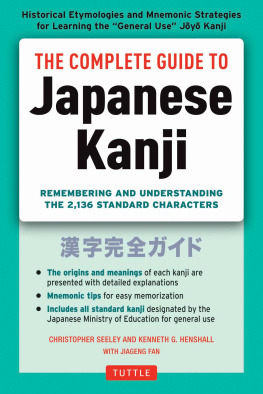

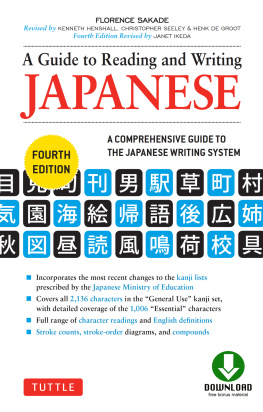
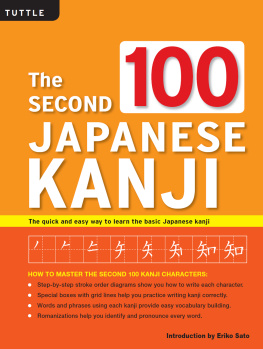
![Eriko Sato - My First Japanese Kanji Book: Learning kanji the fun and easy way! [Downloadable MP3 Audio Included]](/uploads/posts/book/406403/thumbs/eriko-sato-my-first-japanese-kanji-book-learning.jpg)
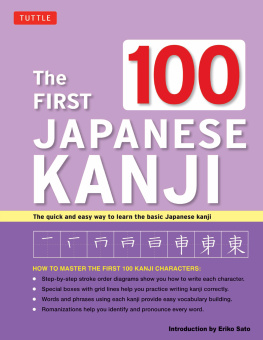
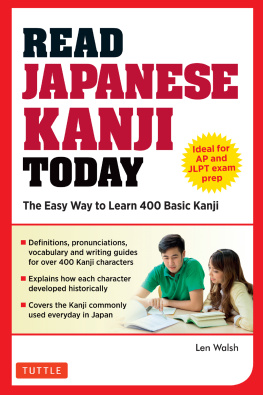
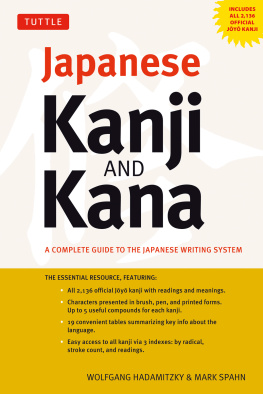
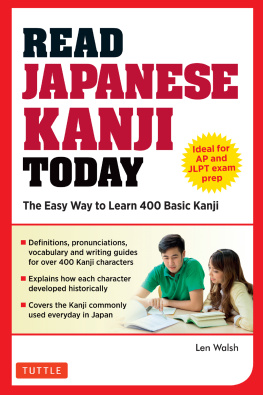
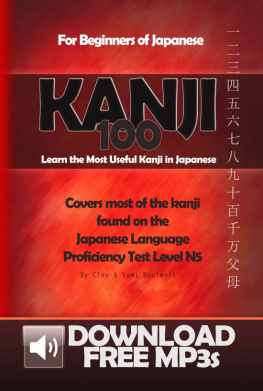
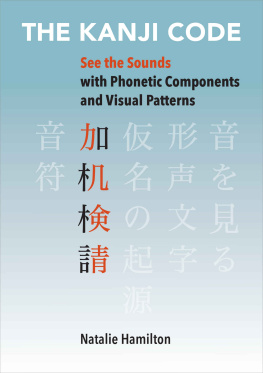
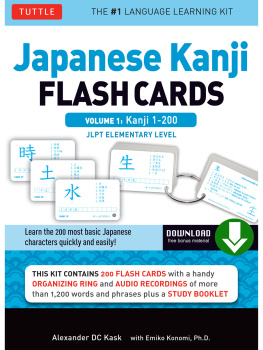

 Note: does not occur at any period as an independent graph, only as an element within a compound graph.
Note: does not occur at any period as an independent graph, only as an element within a compound graph.